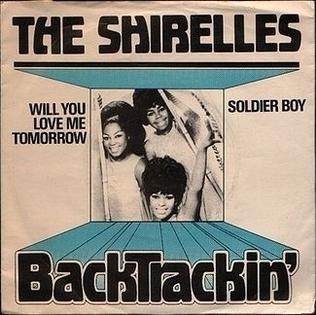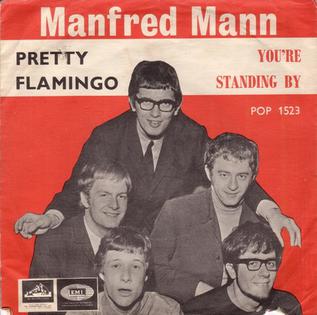
John Dudley Leyton is an English actor and singer.

Ray Peterson was an American pop singer who is best remembered for singing "Tell Laura I Love Her". He also scored numerous other hits, including "Corrine, Corrina" and "The Wonder of You".
"Answer Me" is a popular song, originally titled "Mütterlein", with German lyrics by Gerhard Winkler and Fred Rauch. "Mütterlein" was published on 19 April 1952. English lyrics were written by Carl Sigman, and the song was published as "Answer Me" in New York on 13 October 1953. Contemporary recordings of the English lyric by Frankie Laine and David Whitfield both topped the UK Singles Chart in 1953.

"Itsy Bitsy Teenie Weenie Yellow Polka Dot Bikini" is a novelty song telling the story of a shy girl wearing a revealing polka dot bikini at the beach. It was written by Paul Vance and Lee Pockriss and first released in June 1960 by Brian Hyland, with an orchestra conducted by John Dixon. The Hyland version reached number one on the Billboard Hot 100, selling a million copies in the US, and was a worldwide hit. The song has been adapted into French as "Itsy bitsy petit bikini" and into German as "Itsy Bitsy Teenie Weenie Honolulu-Strand-Bikini", reaching number one on national charts in both languages. Several versions of the song have proved successful in various European countries. In 1990 a version by British pop band Bombalurina, titled "Itsy Bitsy Teeny Weeny Yellow Polka Dot Bikini", reached number one on the UK Singles Chart and in Ireland.

"State of Mind" is a song by Australian singer and actress Holly Valance, from her second studio album of the same name (2003). It was released on 20 October 2003 as the only single from the album, peaking at number 14 on the Australian Singles Chart. The song became her third top-10 single in the United Kingdom, peaking at number eight and spending a total of 10 weeks in the top 100. It was Valance's last single release.
David Spencer, known professionally as Ricky Valance, was a Welsh pop singer. He was best known for the UK number one single "Tell Laura I Love Her", which sold over a million copies in 1960. He was the first male Welsh singer to have a UK number one single hit.

"Teen Angel" is a teenage tragedy song written by Jean Dinning and her husband, Red Surrey. It was performed by Jean's brother, Mark Dinning, and released in October 1959.

"Will You Love Me Tomorrow", sometimes known as "Will You Still Love Me Tomorrow", is a song with words by Gerry Goffin and music composed by Carole King. It was recorded in 1960 by the Shirelles at Bell Sound Studios in New York City, and hit number one on the Billboard Hot 100 chart. The song was the first by an African-American all-girl group to reach number one in the United States. It has since been recorded by many other artists, including a version by co-writer King released on her 1971 album Tapestry.

"Pretty Flamingo" is a song written by Mark Barkan, which became a hit in 1966 when Manfred Mann's recording of it was released as a single. The single reached number one in the UK Singles Chart on 5 May 1966. Manfred Mann's recording was a minor hit in the United States where it spent eight weeks on Billboard's Hot 100 chart, peaking at number 29 during the week of August 6, 1966. It was also successful in Ireland, and was number one there for four weeks, keeping the Rolling Stones' "Paint It Black" at number two.

"I Think We're Alone Now" is a song written and composed by Ritchie Cordell that was first recorded by Tommy James and the Shondells. It was a major hit for the group, reaching number 4 on the US Hot 100 in April 1967. It finished at No. 12 on Billboard magazine's year-end singles chart for 1967.
Lilian Patricia Lita Roza was an English singer best known for her 1953 recording "(How Much Is) That Doggie in the Window?", which reached No. 1 on the UK Singles Chart. She was the first British woman to have a No. 1 hit in the UK chart.

"Crazy Love" is a romantic ballad written by Northern Irish singer-songwriter Van Morrison and included on his 1970 album, Moondance. The song was originally released as the B-side to "Come Running" in May 1970 before it was released as a single in the Netherlands, "Come Running" as the B-side. The cover of the single shows Morrison with his then-wife, Janet "Planet" Rigsbee. The photograph was taken by Elliot Landy, the official photographer of the 1969 Woodstock festival.

Diva is the third studio album by Puerto Rican reggaetón recording artist Ivy Queen. It was released on August 23, 2003 and independently distributed by Real Music Group after being dropped from Sony Discos. The recording followed her two previous studio albums which were commercially unsuccessful and a hiatus from her musical career beginning in 1999. It featured collaborations with Latin hip hop artists including Mexicano 777, Bimbo and K-7 while the album's production was handled by a variety of musical producers; Luny Tunes, DJ Nelson, Noriega, and Iván Joy were enlisted, while DJ Adam produced a majority of the tracks. Lyrically, the album explored female empowerment, infidelity, heartbreak and love with "a veritable compendium of her artistic passion, femininity, and culture". The musical styles of the recording alternate between reggaetón and hip-hop while Queen experiments with R&B, dancehall, and pop balladry.

The Best of Ivy Queen is the first greatest hits compilation by the reggaetón recording artist Ivy Queen released on December 20, 2005, on Universal Music Latin and Perfect Image Records. Disc one contains studio tracks from her third and fourth studio albums, Diva (2003) and Real (2004), while disc two consists of music videos from her discography beginning in 1995 up to 2005 with the release of her fifth studio album, Flashback. Diva was released on August 23, 2003, and independently distributed by Real Music Group. The album follows her two previous studio album which were both commercially unsuccessful. With collaborations with Latin hip hop artists including Mexicano 777 and K-7, the album's production was by a variety of music producers, including Luny Tunes, DJ Nelson and Noriega, while DJ Adam produced a majority of the tracks.

"Where Is the Love" is a popular song written by Ralph MacDonald and William Salter, and recorded by Roberta Flack and Donny Hathaway. Released in 1972 from their album, Roberta Flack & Donny Hathaway. It peaked at number five on the Billboard Hot 100 singles chart and spent a week each at number one on the Billboard Easy Listening chart and R&B chart. Billboard ranked it as the No. 58 song for 1972. The song won a Grammy Award for Best Pop Performance by a Duo or Group with Vocals.
"And I Love You So" is a popular song written by folk singer and guitarist Don McLean and released on his 1970 debut album, Tapestry. Its chorus features an unusual rhyming scheme for a popular song: ABBA versus the usual AB(C or A)B.
"Dile que la quiero" is a song recorded by Spanish singer David Civera, written by Alejandro Abad. It represented Spain in the Eurovision Song Contest 2001, held in Copenhagen.

"Indian Love Call" is a popular song from Rose-Marie, a 1924 operetta-style Broadway musical with music by Rudolf Friml and Herbert Stothart, and book and lyrics by Otto Harbach and Oscar Hammerstein II. Originally written for Mary Ellis, the song achieved continued popularity under other artists and has been called Friml's best-remembered work.

"Je l'aime à mourir" is a French-language song written by Francis Cabrel. It is taken from his second album Les Chemins de traverse released in 1979 that sold over 600,000 copies in France. The single "Je l'aime à mourir" became a hit single for Francis Cabrel in France, Quebec (Canada), Europe and internationally. Spanish singer Manzanita interpreted the song to Spanish flamenco audience making the hit song popular again for the second time. It is considered Cabrel's most definitive hit alongside "Je t'aimais, je t'aime, je t'aimerai".

"Soy de Volar" is a song by Spanish pop group Dvicio, taken from their third studio album Impulso (2020). The song was written by Antonio Escobar, Juan José Martín, Martín Ceballos and Yoby Zuñiga, and produced by Escobar and Pablo Cebrián. A duet version of "Soy de Volar" with Argentine singer Lali was released as the first single from the anniversary edition of Impulso on September 25, 2020, by Sony Music Spain.
















